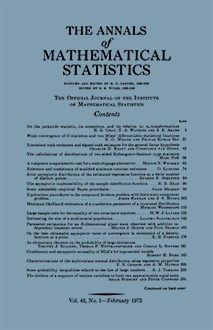Abstract
This paper deals with non-parametric two-sample tests on dispersions. Two samples, $X$- and $Y$-samples of $m$ and $n$ independent observations from populations with continuous cumulative distribution functions $F(u)$ and $G(u)$ respectively, are considered. It is required for the basic test that the difference in locations (medians) of the two populations be known and, when this is so, the two samples may be adjusted to have equal locations. Taking these location parameters to be zero without loss of generality, we test the hypothesis that $G(u) \equiv F(u)$ against alternatives of the form $G(u) \equiv F(\theta u), \theta \neq 1$. The two samples are ordered in a single joint array and ranks are assigned from each end of the joint array towards the middle. The statistic used is $W$, the sum of ranks for the $X$-sample. The distribution of $W$ is studied and tables of significant values of $W$ are provided for $m + n \leqq 20$ and both upper- and lower-tail significance levels .005, .01, .025 and .05. The first four moments of $W$ are developed and a normal approximation to the null distribution of $W$ is devised. Large-sample properties of the $W$-test are considered. A proof of limiting normality is based on a theorem of Chernoff and Savage. Consistency of the $W$-test is indicated and its relative efficiency in comparison with the variance-ratio $F$-test is obtained as $6/\pi^2$ when $F(u)$ is the normal distribution function. Other non-parametric tests of dispersions are reviewed. The $W$-test is less efficient asymptotically than some of these other tests but is easier to apply, particularly with the tables provided. A modified test is suggested for the case where the difference in population locations is not known. This involves replacing the two original samples by two corresponding samples of deviations from sample medians. The procedure of the $W$-test is applied to the two samples of deviations. The properties of the modified test have not been investigated except for a sampling study of rather limited scope. That study indicates that the moments of $W$ for the modified test are not greatly different from those under the basic procedure.
Citation
A. R. Ansari. R. A. Bradley. "Rank-Sum Tests for Dispersions." Ann. Math. Statist. 31 (4) 1174 - 1189, December, 1960. https://doi.org/10.1214/aoms/1177705688
Information





